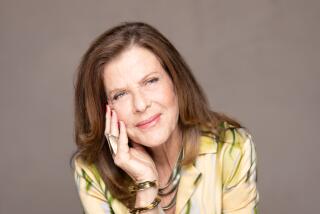Hearst Castle’s Julia Morgan is first woman to win AIA’s gold medal
The American Institute of Architects has broken the gender barrier for its highest award, the gold medal. The 2014 medal is going to famed California architect Julia Morgan nearly 57 years after her death in 1957 and more than 100 years after the first gold medal was conferred.
Morgan, whose most famous building is Hearst Castle at San Simeon on California’s central coast, was “a pivotal figure in the history of American architecture and American women,” according to an article the AIA published on its website announcing the award -- the eighth gold medal awarded posthumously.
Morgan practiced nearly 50 years before her retirement in 1951, designing more than 700 homes, churches, hotels, civic and commercial buildings and museums.
GRAPHIC: Best of 2013 | Entertainment and culture
But the AIA’s online article noted that her reputation eroded as the more austere modernist movement became dominant and the more lavish Beaux-Arts tradition informing Morgan’s work fell out of vogue.
The award, open to residents of other nations as well as Americans, honors “a significant body of work of lasting influence on the theory and practice of architecture.” It’s voted on annually by the board of directors of the AIA, a professional organization headquartered in Washington, but with chapters across the nation. The AIA will celebrate Morgan’s life and work in late June at its annual convention in Chicago. The 2013 award went to L.A. architect Thom Mayne.
Among other winners, 1993 medalist Thomas Jefferson, who died in 1826, waited the longest to be recognized for enduring designs such as his home, Monticello, the Virginia Capitol and original structures at the University of Virginia.
The AIA article noted that Morgan’s candidacy was championed by several celebrated architects who had backed her with letters of recommendation.
Frank Gehry, the AIA’s 1999 gold medalist, disputed the notion that Morgan’s achievement was irrelevant to later architectural advances: “Looking at her work, one can find her playing with symmetry asymmetrically, slipping forms vertically and horizontally, orienting her buildings for climate and daylight, and expressing structure in new ways, pointing the way to Modernism on the horizon.”
PHOTOS: Hawthorne’s best architecture moments of 2013
“Her work mirrored the social and economic burgeoning of California and the changing roles of women,” Philadelphia architect Denise Scott Brown wrote in another letter of recommendation. “Now that we are taking off our blinders, we can see Morgan’s greatness. Including her now will help the profession diversify its offerings to include greater richness and creativity of expression.”
Some feel that Scott Brown herself was unfairly passed over for high honors when the Pritzker Prize, architecture’s most prestigious award, went to her husband and partner, Robert Venturi, in 1991. Los Angeles Times architecture critic Christopher Hawthorne has written that the Pritzker jury “blundered” by not recognizing Scott Brown’s contributions to Venturi’s winning body of work and making it a joint award to both architects.
Earlier this year, a petition drive launched by two graduate design students at Harvard University unsuccessfully urged the Pritzker board to add Scott Brown to the 1991 citation, failing despite thousands of signatures.
The Pritzker has gone to two women out of 38 winners since 1979 -- Zaha Hadid in 2004 and Kazuyo Sejima, who won the 2010 award for work done in partnership with co-winner Ryue Nishizawa.
Nicci Solomons, executive director of the Los Angeles chapter of the AIA, credited Northern California architect Julia Donoho with having “worked tirelessly behind the scenes” to give Morgan her belated due. “It’s exciting that [Morgan] is the first woman, and it does open the door to many amazing women in the profession,” Solomons said in an interview.
Morgan was born and raised in Oakland. She earned a civil engineering degree at UC Berkeley, then became the first woman accepted by the architecture department at the Ecole des Beaux-Arts in Paris.
Morgan designed many buildings in the Bay Area but also created Southern California landmarks.
The former downtown home of the Los Angeles Herald-Examiner at Broadway and 11th Street is a Mission-style structure with Spanish and Moorish influences that opened 99 years ago -- Morgan’s first commission for her leading client, newspaper magnate William Randolph Hearst.
Hearst would later hire her to build his estate at San Simeon -- a decades-long endeavor that produced a sprawling, often gaudy array of structures, including swimming pools and a zoo.
For his mistress, actress Marion Davies, Hearst had Morgan design a beachfront estate in Santa Monica in the 1920s. Its huge mansion, subsequently a hotel, no longer stands, but a guest house on the property lives on as the Annenberg Community Beach House.
In Pasadena, Morgan designed the YWCA building that opened in 1921. Long neglected, it’s now owned by the city, which in June announced that it was in talks with a hotel chain to solidify a plan to restore and operate the building.
Morgan also designed the YWCA in Riverside -- a 1929 building that lives on as the Riverside Art Museum, sporting a Julia Morgan History Wall that tells the architect’s story.
ALSO:
An architect from the inside out
An art that speaks for itself by a woman of few words
A new L.A. identity takes shape in 2013 as city embraces urban life
More to Read
The biggest entertainment stories
Get our big stories about Hollywood, film, television, music, arts, culture and more right in your inbox as soon as they publish.
You may occasionally receive promotional content from the Los Angeles Times.











